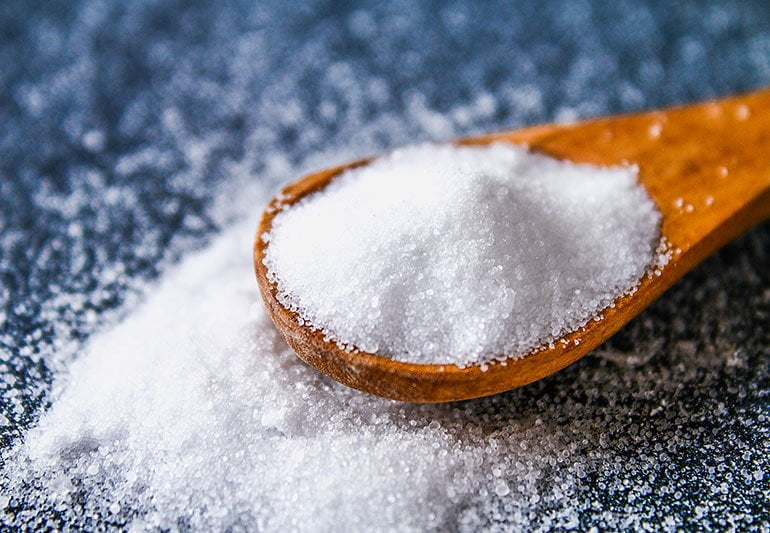
Surprise! Everything You’ve Been Told About Salt Is Wrong
Analysis by Dr. Joseph Mercola January 24, 2024
STORY AT-A-GLANCE
- Eating lots of salt will not make you thirsty or cause greater urine output. A study involving Russian cosmonauts reveal eating more salt actually lowered their thirst — yet increased hunger
- As your salt intake increases, your glucocorticoid hormone level rises, causing greater water availability (hence lower thirst) and increased fat and muscle breakdown — an energy-intensive process resulting in increased hunger
- A high-salt diet will not increase your risk of heart disease. Having the correct potassium to sodium balance influences your risk for high blood pressure and heart disease to a far greater extent than high sodium alone
Editor’s Note: This article is a reprint. It was originally published May 29, 2017.
Do you believe high amounts of salt provoke thirst and contribute to high blood pressure and heart disease? If so, you’re likely wrong. Studies have consistently failed to support either of these notions, showing the converse is actually true. Here’s a summary of findings that may surprise you:
•Eating large amounts of salt will not make you thirsty or cause greater urine output (which could lead to dehydration). A study involving Russian cosmonauts reveal eating more salt actually lowered their thirst — yet increased hunger.
Animal research support these results, showing a high-salt diet resulted in increased metabolism, forcing the animals to eat 25% more calories just to maintain weight. This suggests salt may have a surprising influence on your weight
•Evidence shows having the correct potassium to sodium balance influences your risk for high blood pressure and heart disease to a far greater extent than high sodium alone, and processed foods are typically low in potassium and high in sodium
•Studies suggest a low-salt diet can actually worsen cardiovascular disease and raise rather than lower the risk for early death among patients at high risk of heart disease
•The vast majority, approximately 71%, of your salt intake comes from processed food. Hence, if you avoid processed foods, you have virtually no risk of consuming too much salt. Eating a whole food diet will also ensure a more appropriate sodium-to-potassium ratio
•When lowering salt in processed foods, many manufacturers started adding monosodium glutamate (MSG) instead — a flavor enhancer associated with obesity, headaches, eye damage,8 fatigue and depression. Due to its ability to overexcite neurons, MSG may even raise your risk for neurological disorders such as Alzheimer’s, Parkinson’s and Lou Gehrig’s disease
Counterintuitive Results Show How Poor Our Understanding of Salt Is
It’s pretty bizarre that our understanding about salt is this poor, yet that’s what can happen when you assume the science is settled and you’ve got it all figured out. As reported by The New York Times:9
“If you eat a lot of salt — sodium chloride — you will become thirsty and drink water, diluting your blood enough to maintain the proper concentration of sodium. Ultimately you will excrete much of the excess salt and water in urine. The theory is intuitive and simple.
And it may be completely wrong … [Research] contradicts much of the conventional wisdom about how the body handles salt and suggests that high levels may play a role in weight loss.”
The research is the culmination of a quest by Jens Titze, a kidney specialist at Vanderbilt University Medical Center, who in 1991 became puzzled by the discovery that astronauts’ urine output followed a seven-day cycle. There seemed to be no rhyme or reason for why their urine output would increase and decrease in this cyclical manner.
Your Body Maintains a Constant Sodium Balance Regardless of Salt Intake
Then, in 1994, Titze studied the urine output patterns of a crew on the Mir station, discovering a 28-day rhythm in sodium retention — and that the amount of sodium in the astronauts’ bodies was completely unrelated to their urine output. This was a truly puzzling finding. As noted in the featured article:
“The sodium levels should have been rising and falling with the volume of urine. Although the study wasn’t perfect — the crew members’ sodium intake was not precisely calibrated — Dr. Titze was convinced something other than fluid intake was influencing sodium stores in the crew’s bodies. The conclusion, he realized, ‘was heresy’ …
When the crew ate more salt, they excreted more salt; the amount of sodium in their blood remained constant, and their urine volume increased. ‘But then we had a look at fluid intake, and were more than surprised,’ he said.
Instead of drinking more, the crew were drinking less … when getting more salt. So where was the excreted water coming from? ‘There was only one way to explain this phenomenon,’ Dr. Titze said. ‘The body most likely had generated or produced water when salt intake was high.'”
Salt Has Surprising Metabolic Effects
The other puzzling finding was that the astronauts complained of being constantly hungry when given higher amounts of salt. Interestingly, urine tests revealed they were producing higher amounts of glucocorticoid hormones, which affect both your metabolism and immune function.
Follow-up animal testing confirmed the results, showing the more salt the mice were given, the less water they drank and the more food they required to avoid weight loss. The reason why then became apparent. As the salt intake increased, the animals produced higher amounts of glucocorticoid hormones, causing increased fat and muscle breakdown.
These broken-down muscle proteins are then converted into urea, which is known to help your body excrete waste via urine. Through some still-unknown mechanism, this urea also helps your body retain water. In other words, a side effect of higher salt consumption is that it frees up water for your body to use.
However, this process is energy-intensive, which is why the animals required more food when on a high-salt diet and why the astronauts complained of hunger. Titze believes the increase in glucocorticoid hormones are also somehow responsible for the bizarre cyclical fluctuations in urine output.
“Scientists knew that a starving body will burn its own fat and muscle for sustenance. But the realization that something similar happens on a salty diet has come as a revelation,” The New York Times reports.
“People do what camels do, noted Dr. Mark Zeidel, a nephrologist at Harvard Medical School who wrote an editorial accompanying Dr. Titze’s studies. A camel traveling through the desert that has no water to drink gets water instead by breaking down the fat in its hump.
One of the many implications of this finding is that salt may be involved in weight loss. Generally, scientists have assumed that a high-salt diet encourages a greater intake of fluids, which increases weight. But if balancing a higher salt intake requires the body to break down tissue, it may also increase energy expenditure.”
As noted by Dr. Melanie Hoenig, nephrologist and assistant professor of medicine at Harvard Medical School, “The work suggests that we really do not understand the effect of sodium chloride on the body.”
Sodium/Potassium Ratio Is Key to Normalize Your Blood Pressure
While salt has gotten a bad rap, suspected of increasing your risk for high blood pressure and heart disease, research shows the real key to relaxing your arteries and reducing your blood pressure is actually the ratio of sodium to potassium you have — not your sodium intake alone.
Potassium is a naturally occurring mineral your body uses as an electrolyte (substance in solution that conducts electricity), and it is vital for optimal health and normal functioning. Most of your potassium resides inside your cells, unlike sodium, which resides outside your cells.
Potassium works in your body to relax the walls of your arteries, keep your muscles from cramping and lower your blood pressure. The reduction in blood pressure with added potassium has also been associated in studies with a reduced risk of stroke.
Research in 2014 found that women without high blood pressure who consumed the most potassium (nearly 3,200 milligrams per day) had a 21% reduced risk of stroke. Women who consumed the most potassium were also 12% less likely to die during the study period than those who consumed the least.
A meta-analysis published in 1997, which analyzed 29 trials, also found that low levels of potassium resulted in higher systolic blood pressure readings. Subsequent studies have found similar results.
How’s Your Sodium/Potassium Balance?
It’s generally recommended that you consume five times more potassium than sodium, but most Americans eat twice as much sodium as potassium. If you’re eating mostly processed foods and few fresh vegetables, your sodium-to-potassium balance is virtually guaranteed to be inversed. Imbalance in this ratio not only can lead to high blood pressure but also contribute to a number of other health problems, including:
| Kidney stones | Memory decline |
| Cataracts | Osteoporosis |
| Erectile dysfunction | Stomach ulcers |
| Rheumatoid arthritis | Stomach cancer |
One simple way to check your ratio is to use my customized version of the free nutrient tracker, cronometer.com/mercola, which will calculate your sodium-to-potassium ratio automatically based on the foods you enter.
A great deal of good could come from revising public health recommendations to focus on a high-quality diet rich in potassium rather than sodium reduction, as potassium helps offset the hypertensive effects of sodium. Potassium also has other important health benefits.
Other Health Benefits of Potassium
Adequate amounts of potassium are associated with quicker recovery from exercise and improved muscle strength. As an electrolyte, potassium helps to regulate the fluid balance in your cells and throughout your body. This fluid balance is essential to maintaining life, preventing dehydration at the cellular level and maintaining brain function.
For example, potassium is important in the transmission of nerve impulses in your brain, spinal cord and peripheral nervous system. Nerve impulses transmitting information from one nerve to the next happens as the result of electrical activity. This activity is what an electrocardiogram measures as it tracks heart activity.
Low levels of potassium have also been linked with high levels of insulin and glucose, which are associated with metabolic syndrome and type 2 diabetes. These results have been found in several studies, leading researchers to recommend dietary choices that boost potassium levels.
Your KEY Strategy — Eat Real Food
Getting nutrients from your food instead of supplements is preferable as your food contains more than a single nutrient and in different forms. For instance, potassium found in fruits and vegetables is potassium citrate or potassium malate, while supplements are often potassium chloride.
Green vegetable juicing is an excellent way to ensure you’re getting enough nutrients for optimal health, including potassium. Particularly potassium-rich foods include:
| Swiss chard, 1 cup = 1 gram potassium | Lima beans, 1 cup = 1 gram |
| Avocado, 1/2 Florida variety = 0.8 gram | Dried apricots, 1/2 cup = 0.9 gram |
| Baked potato, 1 large = 0.9 gram | Winter squash, 1 cup = 0.9 gram |
| Cooked spinach, 1 cup = 0.8 gram | Beets, 1 cup = 0.4 gram |
The citrate and malate forms help produce alkali, which may promote bone health and preserve lean muscle mass as you age. Bone loss may lead to brittle bones or even osteoporosis. While potassium in fruits and vegetables may help build bone health, potassium chloride may not. As researcher Dr. Bess Dawson-Hughes from Tufts University explains:
“If you don’t have adequate alkali to balance the acid load from the grains and protein in a typical American diet, you lose calcium in the urine and you have bone loss … When the body has more acid than it is easily able to excrete, bone cells get a signal that the body needs to neutralize the acid with alkali … And bone is a big alkali reservoir, so the body breaks down some bone to add alkali to the system.”
Research by Dawson-Hughes found that people who were in the neutral range for net acid excretion, meaning they had a fairly healthy balance for bone and muscle health, were eating just over eight servings of fruits and vegetables per day along with 5.5 servings of grains. When they rounded this out, it came to about half as many grains as fruits and vegetables.
For many Americans, a simple recommendation to increase your alkali (and potassium) while reducing acid is to eat more vegetables and fewer grains and processed foods in general. When cooking from scratch, you have complete control over how much salt you add.
Healthy Versus Unhealthy Salt
When you do use salt, make sure its unrefined and minimally processed. My personal favorite is Himalayan pink salt, rich in naturally occurring trace minerals needed for healthy bones, fluid balance and overall health. The same cannot be said for modern table salt.
Salt is a nutritional goldmine provided you consume the right kind. Salt provides two elements — sodium and chloride — that are essential for life. Your body cannot make these elements on its own, so you must get them from your diet. Some of the many biological processes for which natural salt is crucial include:
| Being a major component of your blood plasma, lymphatic fluid, extracellular fluid and even amniotic fluid |
| Carrying nutrients into and out of your cells and helping maintain your acid-base balance |
| Increasing the glial cells in your brain, responsible for creative thinking and long-term planning. Both sodium and chloride are also necessary for the firing of neurons |
| Maintaining and regulating blood pressure |
| Helping your brain communicate with your muscles so that you can move on demand via sodium-potassium ion exchange |
| Supporting the function of your adrenal glands, which produce dozens of vital hormones |
Natural salt typically contains 84% sodium chloride and 16% naturally-occurring trace minerals, including silicon, phosphorous and vanadium. Processed (table) salt, on the other hand, contains over 97% sodium chloride; the rest is man-made chemicals such as moisture absorbents and flow agents. A small amount of iodine may also be added.
Some European countries, where water fluoridation is not practiced, also add fluoride to their salt. In France for example, 35% of table salt sold contains either sodium fluoride or potassium fluoride, and use of fluoridated salt is widespread in South America.
Besides these basic differences in nutritional content, the processing also radically alters the chemical structure of the salt. So, while you definitely need salt for optimal health, not just any salt will do. What your body needs is natural, unprocessed salt, without added chemicals.
At Ron’s the salt we use is Natural Sea Salt and is a product of Italy

